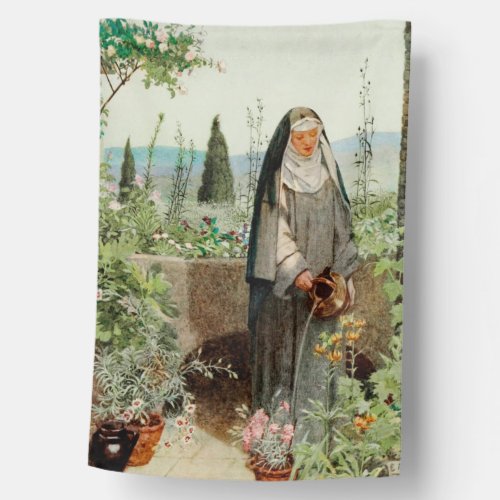1-sided St Clare of Assisi Watering Flowers (M065) House Flag



Also available as a two-sided variant for an additional cost. NOTE WELL: This flag has printing only on the front. The back is totally blank. Adding ANYTHING to the backside—a word, an icon, a picture, even a white or solid background color—will trigger a surcharge/an upcharge! + Franciscan Spirituality has its origin in the life and thought of St. Francis of Assisi (1181/1182-1226), composer of the Canticle of the Sun. Among its principles are an emphasis on responsible stewardship for the environment and a deep belief in the interconnectedness of man and nature as reflections of God, the Creator of All Things. Here, St. Clare of Assisi (1194-1253), the first woman to embrace Franciscan Spirituality, is depicted watering potted plants. + Born Chiara Offreduccio of a noble house, the future St. Clare was expected to marry well and add wealth and prestige to her family. Instead, in 1212, having heard St. Francis preach, and together with her aunt and a companion, she abandoned rank and privilege to become a nun, a bride of Christ. St. Francis would become St. Clare's spiritual mentor and life-long friend. + Despite attempts by her father to force her back home, St. Clare persevered in her vocation. Housed initially after her ‘elopement' at Benedictine nunneries for formation in the religious life and until proper accommodations could be arranged, St. Clare was later installed in a small dwelling adjoining the Church of San Damiano where she was joined by her sister and several other noble ladies. At first, she served as prioress of the convent under the direction of St. Francis, who provided not a Holy Rule but a more informal "formula vitæ" or general directive to practice the counsels of the Gospel. In 1216, she became abbess, a post that afforded her and her convent greater independence from the male church hierarchy. She was the first woman in Western Europe to compose a rule of monastic life for women, a rule that emphasized absolute poverty for the community as a whole not just for its individual members. The order, the Second Order of St. Francis, originally known as the Poor Ladies of San Damiano, would later come to be called the Poor Clares. St. Clare died after years of ill health in 1226. + Like the Franciscan brotherhood, St. Clare's sisterhood was self-sustaining surviving on alms and the labor of its members. Its enclosed or cloistered nuns, who abstained from meat, grew their own fruits and vegetables as well as medicinal herbs and flowers. In recent years, St. Clare Gardens patterned after Medieval monastic gardens have been increasing in popularity. They are characterized by an emphasis on naturalness and sustainability. + Feast: August 11 + Image Credit (M 065): Antique image of St. Clare of Assisi from Eleanor Fortesque Brickdale's Golden Book of Famous Women (London, New York, and Toronto: Hodder and Stoughton, 1919), f. p. 180. Eleanor Fortescue-Brickdale (1872-1945) was an English artist known for her paintings, book illustrations, and a number of works in stained glass.


